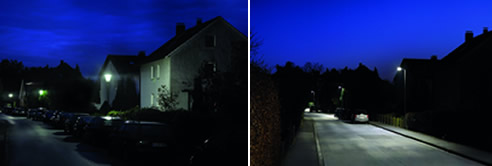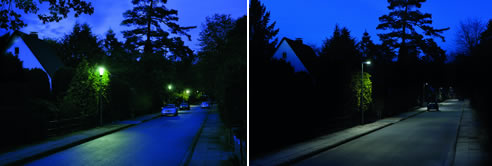Lowering Energy Costs with Improved Light Quality from WE-EF Lighting The city of Bielefeld, Germany is now able to reduce its power consumption for public street lighting by 1.8 million kWh per year. The main reason for the savings, at a time of continuously rising cost pressures, was the replacement of 5,889 existing luminaires with modern WE-EF VFL540 LED street and area lighting luminaires. The extensive retrofit has provided the city with considerable gains regarding energy savings, CO2 reduction and light quality. It also provides an excellent example of the competencies required from lighting designers when transferring to a technology using LEDs while maintaining the existing pole and luminaire locations. Good reasons for a change In 2010, Bielefeld was still operating some 16,000 street lighting luminaires with mercury vapour lamps. However, from 1999, compact fluorescent lamps (TC-L) and metal halide lamps were used as an alternative when repairs or replacement were necessary. Yet, as late as 2010, almost 50 per cent of the city's street lighting still relied on mercury vapour lamps. The binding introduction of the European Union Regulation 245/2009 (Eco-Design Directive), which prescribes that mercury vapour lamps may no longer be brought into circulation as of April 2015, created an urgent need for action and prompted the city to immediately prepare a concept to implement these requirements. Motivated by the considerable energy savings, and thus more cost-effective and ecological operation of street lighting systems, together with much lower maintenance costs, Bielefeld quickly began focusing on LED technology. A decisive factor in favour of this decision was the fact that the community, which was operating under an emergency budget, was able to partially cover the investment costs for the technology with subsidies from a special programme of the Federal Ministry for Environment, Nature Conservation and Reactor Safety (BMU). Impressive technology coupled with timely delivery Immediately following BMU's approval of the subsidies, the city initiated a public tender process, in which WE-EF was successful with its VFL540 LED luminaires. Since Bielefeld was required to access all subsidies in the current budget year, the entire project had a very tight time frame of six months. Hence the just-in-time delivery of the 5,890 luminaires became an important success factor - a task that WE-EF was able to meet with 100 per cent delivery reliability. The client was able to witness the technical lighting performance of the VFL540 LEDs as part of an on-site trial process. The WE-EF LED luminaires have a nominal power input of only 21 W, compared with 89 W of the original mushroom-shaped opal glass luminaires. Thanks to their tailored optical components, the LED luminaires deliver significantly more light to the target area and prevent unnecessary light spillage. The city of Bielefeld measured the illuminance of the old and new luminaires, in order to reach an objective statement of the effects of the new lighting on the roadways. The original mushroom luminaires, with their concentric light distribution around the pole, only added 0.1 lux to the roadways from a distance of 12 metres. The new LED luminaire generated at least 0.2 lux on the edge of a significantly bigger 12 x 35 metre evaluation field. In addition, the existing luminaire poles had to be extended by 1 metre or 1.25 metres to a height of five metres to achieve the optimal light distribution. WE-EF was able to offer a cost-effective and aesthetically attractive solution. The considerable value retention that can be achieved by using the existing poles is recognised by those in charge in Bielefeld, as this part of the project must be fully financed from the city's own funds.
Optimal visibility for vehicles and pedestrians On main and residential streets, which are generally eight to 10 metres wide, the installed VFL540 LED luminaires provide significantly more illumination. In these standard situations, the luminaires are fitted with [S70] lenses. They generate a street lighting distribution that illuminates the entire width of the road - including the path for pedestrians on the opposite side as well as the footpath behind the luminaire for up to two metres in width from one side of the street. The uniformity of lighting has also been improved considerably. The distance between the poles, which ranges from 35 metres to 40 metres, provides very good longitudinal uniformity as well as a high overall uniformity on the road surface. Dark zones that impair the perception of obstructions on the street, or which put pedestrians and bike riders on the edge of the road at risk, can be almost entirely eliminated. Another advantage of the precisely defined distribution is the prevention of unnecessary light spillage - the occurrence of building facades and gardens previously lit by streetlighting luminaires has been reduced considerably. Dark sky concerns are also more than satisfied by WE-EF luminaires. Special situation, special solution For special situations where footpaths wider than two metres existed, WE-EF engineers developed an appropriate solution with two additional LED modules integrated into the luminaire. This provided additional light that extended beyond two metres behind the luminaire. This modified luminaire type, now available with a connected rating of 32 W, was installed at 130 locations. The special luminaire provides better visual conditions, not just in the above-mentioned application but also for adjoining streets. It was used where the first luminaire in the ancillary direction was located more than 17 metres from the crossing street. Modification for especially wide roads Another adaptation of the VFL540 LED version was useful for streets that were more than 12 metres wide. In those sections, the LED luminaires still generated considerably higher illuminance than the original mushroom luminaires on the opposite footpath, but the builder requested that this value be increased. A slight improvement was achieved by integrating an [S60] lens before the two centre-front LED modules in the luminaire. The illumination of those roads will be significantly improved with the integration of further developed [R65] lenses, which will be delivered in May 2012. This optical component features a light distribution that is wider towards the front, so that more light reaches the footpath on the opposite side of the roadway. This modification will be applied to 360 luminaires. They effectively illuminate the more than 12-metre wide roads, and prove their value at turning areas and intersections. Renovation is a reality As with any renovation project, the retrofit process in Bielefeld will also require the ability to adapt to the structural conditions that have evolved over the years. For example, 390 poles could not be extended to the required 5 metres due to structural or access issues. In some road sections, technicians encountered distances of 50 to 60 metres between poles and, in some cases, even 80 metres. "Of course such restrictions require compromises", says Mark Malitzki, who is responsible for the Bielefeld project at WE-EF. "However, in the final analysis, we can say that the retrofit brought about objective advantages in all cases. While dark zones do occur in situations in which there are very long distances between poles, overall visual conditions are much better than before, as the lit areas are now much brighter." "During the acceptance process, we documented such weaknesses of our system and prepared a priority list for future adjustments", adds Hans-Werner Schuette from the Bielefeld transportation authority. "This list will be worked through during the next couple of years, depending on the personnel and financial options available to Stadtwerke Bielefeld GmbH and the city of Bielefeld. However, we are already in a position to reach a positive conclusion following the retrofit - with regard to significantly reduced energy costs and CO2 emissions, the newly obtained light quality and in view of the smooth process, notwithstanding the enormous scope of this project."
|
03 8587 0400 6/13 Downard Street, Braeside, Vic, 3195
|



 Modern Catenary Solution Fit for
Modern Catenary Solution Fit for WE-EF's New Managing Director for
WE-EF's New Managing Director for A New Era for WE-EF LIGHTING – A Home
A New Era for WE-EF LIGHTING – A Home Myers Park Lighting Upgrade:
Myers Park Lighting Upgrade: Bridging the Past and Future: Old Murray
Bridging the Past and Future: Old Murray WE-EF Profile Projectors for Sharper
WE-EF Profile Projectors for Sharper Award-winning Bay Pavilions, Arts +
Award-winning Bay Pavilions, Arts + Enhancing Transit Experience at Byron
Enhancing Transit Experience at Byron Intelligently Illuminating the Bay Run
Intelligently Illuminating the Bay Run WE-EF Lighting's Role in Protecting
WE-EF Lighting's Role in Protecting Sustainable LED Upgrade Kit from WE-EF
Sustainable LED Upgrade Kit from WE-EF A Natural Paradise Rottnest Island by
A Natural Paradise Rottnest Island by WE-EF LIGHTING's Braeside Expansion
WE-EF LIGHTING's Braeside Expansion Street and Area Pole-Mounted Luminaires
Street and Area Pole-Mounted Luminaires Smart Lighting Control Technology from
Smart Lighting Control Technology from High-Output Floodlights with Modern LED
High-Output Floodlights with Modern LED Bondi Beach Pavilion Reimagined by WE-EF
Bondi Beach Pavilion Reimagined by WE-EF Balancing Needs: Sea Turtle Conservation
Balancing Needs: Sea Turtle Conservation Architecturally Pleasing Recessed
Architecturally Pleasing Recessed Luminaires for Lake Macquarie Multi-Arts
Luminaires for Lake Macquarie Multi-Arts
